[Introduction: This was our first article about the then-just-announced Fuji X100, first of the five iterations so far. The little camera launched the range of Fujifilm mirrorless products that currently has the company at No. 4 in market share globally among makers of dedicated ILCs.
The original title was "Beautiful Fuji."—Ed.]
-
(Originally published September 19th, 2010)
This is certainly the most enjoyable camera news I've gotten in a long while. Fujifilm has made a "development announcement" at Photokina for a camera to be called the X100: a high-quality, fixed-lens, 12-MP, viewfinder-window compact digital camera with an APS-C sensor. The lens is a 23mm ƒ/2 Fujinon...exactly equivalent, in 35mm terms, to a 35mm ƒ/2.
The executive summary is that this camera was built from the ground up to optimize image quality as much as possible.
Here are the major points:
Viewfinder: What will undoubtedly get the most press and be the subject of the most talk in the days and weeks to come is the all-new viewfinder concept. You say you want an optical viewfinder (OVF)? You say you sometimes prefer an electronic viewfinder (EVF)? Well, how about both? Together? In the same viewfinder?
In the picture of the front of the camera, above, see that little lever at the upper left of the lens? That lever allows you to switch instantly between an OVF and an EVF.
Here's how it works. In a normal rangefinder OVF, extra light is gathered from a separate window and used to project the framelines into the prism, which has a splitter in it to allow the two images to superimpose for your eye. What Fuji has done here—a really rather brilliant idea—is to simply dispense with the optical framelines and project a 1.4 MP LCD screen on top of the optical view. This allows them to put bright lines and full information (even a little histogram) into the optical viewfinder; or, you can flip the switch and see exactly what the lens sees as an EVF. Your choice. You can change at will depending on conditions. Oh, and the brightness of the superimposed information in the OVF changes with the intensity of the light, so it never washes out or becomes hard to see. Brilliant. I hope it works as well as it sounds like it does.
 (Click on this image to see a larger version)
(Click on this image to see a larger version)
The lens: Fuji, of course, has been a lensmaker for a long time. Its Fujinon lenses have graced many of its cameras for many decades, and its view camera lenses were highly thought of and sought after for years. Fuji says its 23mm (35mm-e) ƒ/2 in the X100 was developed in tandem with the all-new sensor to optimize image quality...in fact, the company says the X100 will have the highest image quality ever offered in any FinePix. And the new lens is a big part of that.
The lens has a design of 8 elements in 6 groups, with one really radically-shaped press-molded (all glass) aspherical element (check it out, below). It functions as a near-macro lens in that it focuses to 10 centimeters (less than 4 inches), and it is said to achieve its highest contrast at only 1–2 stops down (the MTF diagrams at the Fuji site give graphs for ƒ/2 and ƒ/4, which usually means ƒ/4 would be the optimum aperture).
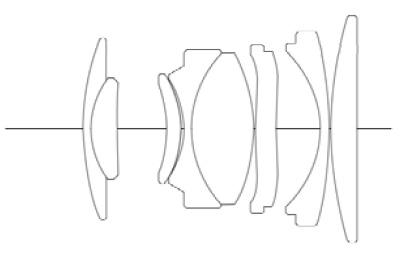 Cross section. Objective on the left, exit pupil on the right.
Cross section. Objective on the left, exit pupil on the right.
Note the extreme aspheric (element 6) and the huge
"follower" (a field-flattening element) on the right.
And get this—it's got a built-in (but of course optional) –3 neutral density filter, for when you want to shoot wide open and get lots of bokeh in bright light!
Crazy, man, crazy.
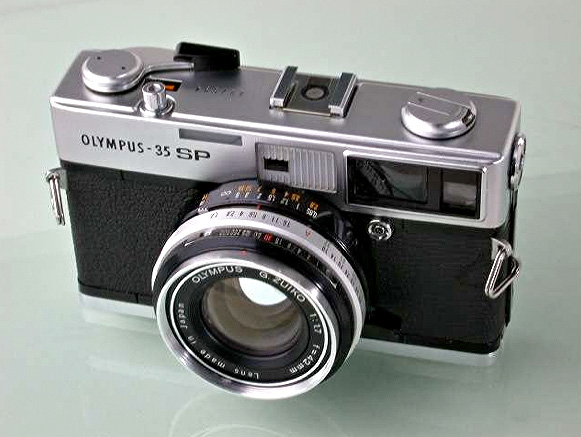 Classic Olympus 35 SP of 1969. Photo by D. Scott Young.
Classic Olympus 35 SP of 1969. Photo by D. Scott Young.
Finally, Fuji says the lens was designed to be as physically short as possible, in keeping with the compact-camera ethos, but it was deliberately made not to collapse in or telescope back out so that the camera will be ready to shoot the instant it's turned on.
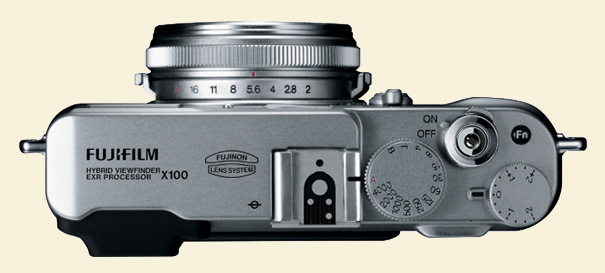
Top view—note the real aperture ring, with finger grips. All the dials are metal. Fuji says the camera was designed so that the basic settings could be set with the camera off and confirmed visually at a glance with the camera off or on—old-fashioned functionality to go with the old-fashioned styling.
The sensor and processor: The X100 "features a custom CMOS high-performance sensor, internally optimized and developed exclusively for this model." The lenses over the photosites are shifted incrementally more towards the edges of the sensor, à la the M9, to maximize sharpness at the edges and corners and minimize falloff. The newly-designed EXR processor. Fuji says, "Throughout development of the processor, Fujifilm has re-examined every aspect from response to the circuit structure, and achieved a significant leap in signal processing performance."
Design: Obviously a retro design that conjures rangefinders of days gone by (engadget calls the X100 "rangefinderesque"). The main point to be made about the design is that, like the Digital Pen before it, the X100 seeks to give photography enthusiasts what many of us want—a digital camera with some distinctiveness and object-quality, one that isn't just another rounded lump of black polycarbonate or yet another magnesium frame with a rubbery covering.
Incidentally, there's a video at engadget [link removed 'cause it's broken now —Ed.].
I'll of course have more about this as we learn more—the official introduction isn't until Tuesday. Meanwhile, a last thought: Fuji says in its press release that "Fujifilm has closely studied the current line-up of professional cameras and feels that there is a strong need for a compact high-quality (APS-C based) camera as a counterpoint to an SLR." Here's what I said five years ago, when I first called for the type of camera we've finally been getting lately: "It would be a second camera, in the way that a two-seater sports car is a second car. It would be neither a do-everything camera nor a replacement for a DSLR, but rather a complement to a DSLR." Looks like our choices in the two-seater category just got that much richer.
—Mike
ADDENDA:
1. I heard from "our man in Japan" (he's not really our man, just a friend) who says that the prevailing rumor there (I should emphasize the word rumor) puts the X100 at ¥120,000 to ¥150,000 (that's $1,399 to $1,749). I.e., undercutting only the Leica X1. So those of you hoping for a "friendly" price might have to wait more like two or three years.
2. While the camera is remarkably close to "the DMD" from what we know so far, don't forget that a crucial part of the DMD spec is, "Has to be—must be—razor quick. As good as the best pro DSLRs," with fast AF that works positively in low light. That aspect of the X100 will have to await actual testing, but, on the evidence of cameras like the DP1 and DP2, E-P1 and E-P2, and X-1, it's not something that cameramakers are finding easy to implement in compacts.
3. Fuji is calling for release in "early 2011." Total coincidence: my birthday is in late February. Might be looking to buy myself a birthday present. I'm just sayin'.
Original contents copyright 2023 by Michael C. Johnston and/or the bylined author. All Rights Reserved. Links in this post may be to our affiliates; sales through affiliate links may benefit this site. As an Amazon Associate I earn from qualifying purchases. (To see all the comments, click on the "Comments" link below or on the title of this post.)
Mike is on vacation this week. Comments will be posted promptly, but there will be no Featured Comments on these republished articles.
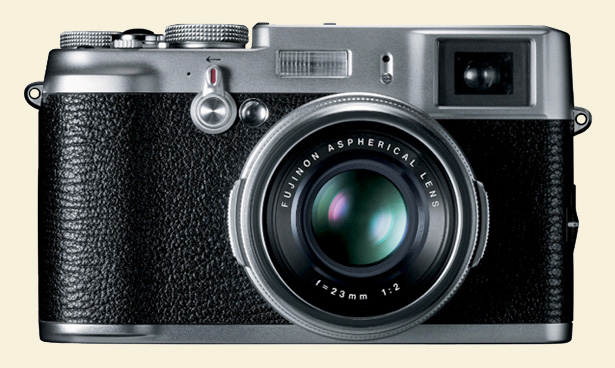
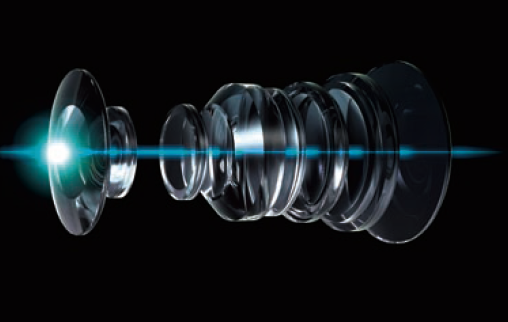
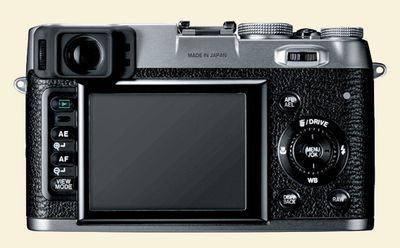



Ah, the original X100. I was the first guy in line to buy it after driving 50 miles to the big city (Orlando, Fl) after convincing the camera shop owner on the phone that I was a serious customer and guaranteeing the purchase if he'd hold the new model in the back until I arrived. He did and I bought it.
I was enthusiastic about this model after numerous semi-reviews from magazine people that got to handle this model at various trade shows before its release. Coming from decades of Leica M photography, this looked like my camera for the digital world. The reality was not as good as the expectations.
The first shock was that after setting up the menu and playing with the camera in the house to get familiar with it, I drove to a location to test it out. I got 26 photos before the battery died. It went from full bars to red flashing warning in minutes. I could use my Nikon D700 for a month and never kill the battery, so that was a shock. Charging the battery took hours, killing it took minutes, not a good ratio.
The autofocus was slow and not precise enough to use the optical finder. Too many times the lens focused on the wrong thing, so I went with the EVF, which drained the battery faster.
The write times for the files to load was ridiculously long. The camera would have the files stack up and prevent further shooting for several seconds after just a few quick frames.
I still have this camera and take it out once a year or so for kicks, but it never was the tool that I thought it would be. Fortunately, I gave Fujifilm another chance around the time of the X-T2 and boy, did they get that right!
Posted by: Albert Smith | Wednesday, 27 December 2023 at 10:05 AM
What a coincidence. A friend in the UK recently offered me an original X100, which reached me here in Zambia just before Christmas. I love the optical finder on my X-Pro 2, so I'm looking forward to using the X100.
Posted by: Richard Alton | Thursday, 28 December 2023 at 03:25 AM